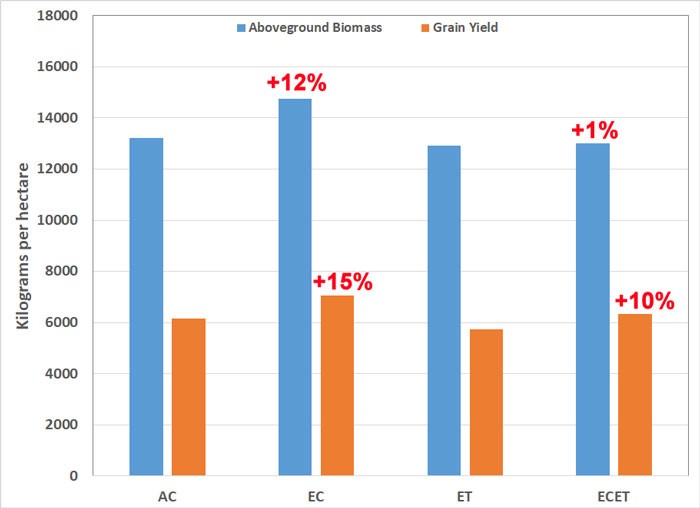From CO2Science: In a recent paper published in the journal Field Crops Research Lenka et al. (2021) investigated the single and combined effects of elevated CO2 and temperature on wheat, focusing primarily on its growth and yield and its nitrogen content, concentration and use efficiency. The experiment was conducted over the course of three consecutive growing seasons at the experimental farm of the ICAR-Indian Institute of Soil Science in Bhopal, India, in the humid subtropics. Wheat (Triticum aestivum, cv HI-1544) plants were grown in the field in open-top chambers under one of four treatment conditions, ambient temperature and ambient CO2 (AC), ambient temperature and elevated CO2 (EC), elevated temperature and ambient CO2 (ET), and elevated temperature and elevated CO2 (ECET), where elevated temperatures and elevated CO2 concentrations were maintained at approximately 1.8°C and 130 ppm above ambient conditions, respectively. And while the elevated temperature treatment (achieved using infrared heaters) was applied 24 hours per day, elevated CO2 was applied during daylight hours only. And what did the experiment reveal?
Paper Reviewed: Lenka, N.K., Lenka, S., Yashona, D.S., Shukla, A.K., Elanchezhian, R., Dey, P., Agrawal, P.K., Biswas, A.K. and Patra, A.K. 2021. Carbon dioxide and/or temperature elevation effect on yield response, nutrient partitioning and use efficiency of applied nitrogen in wheat crop in central India. Field Crops Research 264: 108084, doi.org/10.1016/j.fcr.2021.108084.
Pooling their data for the three years, Lenka et al. report wheat plants experienced a “significant yield advantage and recovery of applied fertilizer N with CO2 elevation.” In particular, as shown in the figure below, the approximate 130 ppm rise in atmospheric CO2 in the elevated CO2 treatments stimulated the aboveground biomass and grain yield by 12% and 15% respectively under ambient air temperature conditions and by a smaller 1% and 10% under elevated temperature conditions. The researchers also report elevated CO2 increased the total N uptake of the wheat plants by 16%, adding that “all [four] nitrogen use efficiency indices [examined] were significantly higher under elevated CO2 as compared to ambient.” More specifically, elevated CO2 stimulated the agronomic efficiency, crop recovery efficiency, physiological efficiency and partial factor productivity of applied N by 43%, 39%, 28% and 15%, respectively, which improvements undoubtedly aided in achieving the biomass increases in the elevated CO2 treatments.
Finally, Lenka et al. report that “seed N concentration was significantly higher under ET and ECET treatments as compared to ambient,” which finding indicates elevated CO2 had a positive influence on the nutritional quality of the wheat. Taken together, the results of this study represent good news for the future of wheat production as the air’s CO2 content rises.

Figure 1. Average aboveground biomass and grain yield of wheat across three growing seasons in the four experimental treatment conditions. The percentages in red text indicate the percent increase in aboveground biomass or grain yield due to elevated CO2 at a given temperature treatment. Data for this figure were derived from the authors’ Figure 2.


